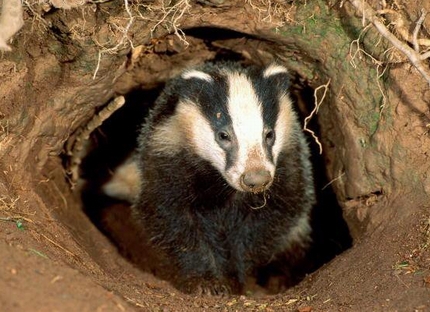Badgers are members of the weasel family and have the musky odor characteristic of this family. They are especially adapted for burrowing, with strong front legs equipped with long, well-developed claws. Their digging capability is used to pursue and capture ground-dwelling prey. Typical burrows dug in pursuit of prey are shallow and about 1 foot (30 cm) in diameter. A female badger will dig a deeper burrow (5 to 30 feet long [1.5 to 9 m]) with an enlarged chamber 2 to 3 feet (0.6 to 0.9 m) below the surface in which to give birth. Dens usually have a single, often elliptical entrance, typically marked by a mound of soil in the front.
Badgers have a rather ferocious appearance when confronted, and often make short charges at an intruder. They may hiss, growl, or snarl when fighting or cornered. Their quick movements, loose hide, muscular body, and tendency to retreat quickly into a den provide protection from most predators. Larger predators such as mountain lions, bears, and wolves will kill adult badgers. Coyotes and eagles will take young badgers.
Badgers are active at night, remaining in dens during daylight hours, but are often seen at dawn or dusk. During winter they may remain inactive in their burrows for up to a month, although they are not true hibernators. Male badgers are solitary except during the mating season, and females are solitary except when mating or rearing young. Densities of badgers are reported to be about 1 per square mile (0.4/km 2) although densities as high as 5 to 15 badgers per square mile (1.9 to 5.8/km2) have been reported. An adult male’s home range may be as large as 2.5 square miles (6.5 km2); the home range of adult females is typically about half that size. Badgers may use as little as 10% of their range during the winter.
Badgers breed in summer and early fall, but have delayed implantation, with active gestation beginning around February. Some yearling females may breed, but yearling males do not. As many as 5 young, but usually 2 or 3, are born in early spring. Young nurse for 5 to 6 weeks, and they may remain with the female until midsummer. Most young disperse from their mother’s range and may move up to 32 miles (52 km). Badgers may live up to 14 years in the wild; a badger in a zoo lived to be 15 1/2 years of age.

I was born and raised in Texas and have spent most of my life in and around Lampasas and Austin ; and much of that time in rural areas. I have traveled widely and have done a lot of geophysical work in which I have spent substantial time in places like the prairies of West Texas and the forests of the Pacific Northwest. I was a proud member of the “Lampasas Badgers” in High School. I am 70 years old; but I have to say that I cannot recall ever having seen a badger in the wild. Not even one. Is this normal? I think I have seen and encountered most other wild life that are commonly known to reside in the USA. Are badgers presently known to exist at the density of about one per square mile? Are they extremely good at hiding? Thanks for your information on this site; and I will appreciate your comments on this.
Sincerely,
Darrell Word
That’s pretty cool. BTW, I love the pictures along the side! I am doing research on badgers for school and this was awesome!
We have badgers where I live in California. I never see the animal as they’re nocturnal but I do run across their diggings once in a while. The diggings are sort of “crescent moon” shaped with a big pile of dirt to one side.